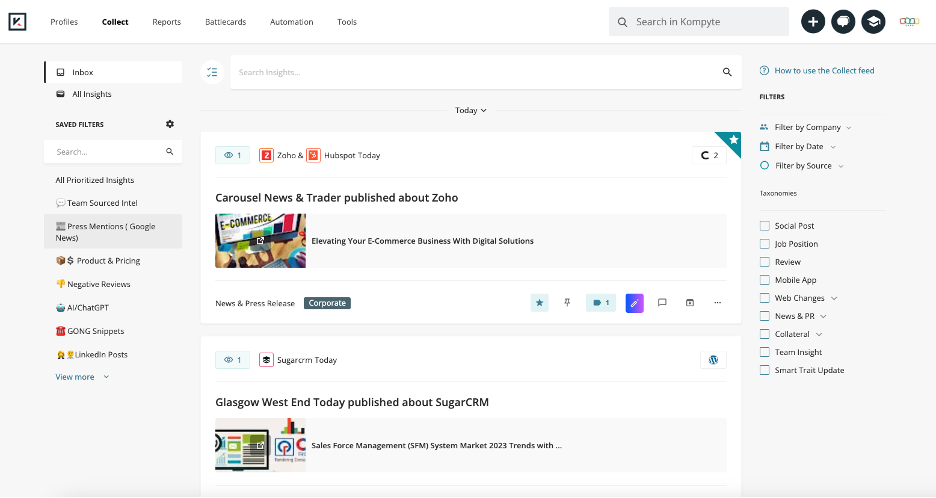Corporate Competitor Analysis Tactics to increase competitive win rate
Competitive Analisis Report (Part II): Spot the different types of competition and evaluate your competitors to better compete with them.
Direct competitors show you how to keep up, but indirect competitors can inspire you and help you stay ahead of the curve.

“Keeping up with the Joneses” is more than an old-fashioned suburban idiom; it’s a solid business strategy.
By following what your competition does—successful campaigns, marketing strategies, etc.—you can put together your own roadmap to success and find ways to be distinctive.
The obvious approach is to follow your direct competitors. You’re competing with them for market share, addressing the same audience, and essentially putting out the same products.
But if you’re looking to stand out, you should watch your indirect competitors, too.
Direct and indirect competition make up two halves of your intelligence reporting. They paint a complete picture of your market landscape by showing you the seen and unseen motivations of your customers.
A direct competitor is a business that offers similar products or services as you within the same market. For example, Nike and Adidas are classic direct competitors. They serve the same market. When a buyer is looking for an athletic shoe, they will choose between one of these two companies.
They also offer products at similar price points and of similar quality. A price increase by one may drive consumers to the other, and any market trends may affect both of them.
Direct competitors are easy to track, and you usually know exactly who they are. You may follow their press releases, and social media channels, and frequent their online and physical stores.
You can learn a lot about your market by following your competitors, including:
But if you want a wide-view lens of the market, you also need to check out your indirect competitors.
Indirect competitors provide offers and products to similar markets as yours but do not compete directly for market share.
Continuing with the shoe example, an indirect competitor to Nike would be Jimmy Choo or Steve Madden. They all sell shoes to people who need footwear, but the customer demographics are different.
Indirect competitors sell the same solution as you do, but differently.
|
Direct Competitors |
Indirect Competitors |
|
Sell similar products or services |
Sell different products in the same category |
|
Products are of equal quality and price point |
Products may be of different quality and price point |
|
Sell to the same type of customer |
Meet the same customer needs, but serve a different demographic |
|
Operate in the same geographical market |
Operate in different geographical markets |
To make sure you understand who your indirect competitors are—and how to find your own indirect competitors—here are a few more scenarios. In each case, the products may be very different, but they satisfy a similar need or target a similar audience
Your local gym and that app on your phone are indirect competitors. Both help people achieve fitness goals, but while the gym offers equipment and in-person classes, the app might offer on-demand video classes, diet tracking, or online fitness challenges. People may in fact use one or more apps AND go to the gym.
Right outside the local movie theater, you’ll find a chocolate shop and an ice cream shop. They are indirect competitors because they both service buyers who need a sweet treat.
If the chocolate shop raises their prices or has a supplier issue, it probably won’t affect the ice cream shop.
People may choose ice cream over chocolate as a simple matter of personal preference. But each business should do all they can to make their storefront and products look more appealing than the other.
It’s a rainy day and you’re heading out the door. Do you pick up your umbrella, a hat, or your raincoat? While all very different, there are many ways to meet your current need to stay dry. If you sell hats while someone else sells raincoats and umbrellas, your accessories store is suddenly in indirect competition with the department store down the block.
Bookstores and e-readers like Amazon’s Kindle may offer the very same books to eager readers. But the brick-and-mortar store caters to those who like to browse the shelves and then hold a book in their hands, drinking in that sweet, new-book smell. E-readers serve those who prefer a digital experience they have in their pockets at all times.
Indirect competitors push you to think outside the box and take a look at the entire market, not just the segment you serve.
Here are a few benefits you can gain from tracking indirect competition:
Tracking your competitors often means watching their social media pages and updates, website changes, press releases, hiring trends, and more (read about the best sources to start with). You have a few options for gathering info:
By now, the value of expanding your competitive analysis to include indirect competition is clear. Widening your peripheral vision can inspire and empower you to make data-driven business and marketing decisions.
So, if you’re ready to track your indirect competitors, what should you do next?
2. Determine what you’ll track
What you track depends on what you want to learn! If you’re mainly interested in product updates, track those pages. If investor and financial information is important, track that. Unlike with your direct competitors, you probably won’t want to track everything. Still, when you are in the “analysis” stage, look more broadly at their online properties to see what you can learn. Then narrow down your data sources for ongoing tracking.
3. Set up a tracking system and process, with ownershipWhether you use a simple spreadsheet or employ competitive intelligence automation, you’ll want to establish the following:
Kompyte has a built-in Collect Feed feature that gathers news updates and even web changes of all your competitors. Simply enter which companies you want to keep an eye on and Kompyte will do the rest. You can even designate certain competitors as “indirect” and filter them out of the default view, only reviewing their updates when it’s time.

Unlock the full potential of your competitive intelligence by streamlining your tracking and analysis. Schedule a demonstration of Kompyte today to turn your peripheral vision into your newest superpower.
Competitive Analisis Report (Part II): Spot the different types of competition and evaluate your competitors to better compete with them.
Manually researching competitors is inefficient. Read how you can use competitive intelligence solutions to maximize your time instead of getting...
How to Make Competitive Intelligence Work with Lots of Competitors. Check out these 5 tips to keep up with CI in a Hyper-Competitive Market.
Be the first to know about new B2B SaaS Marketing insights to build or refine your marketing function with the tools and knowledge of today’s industry.